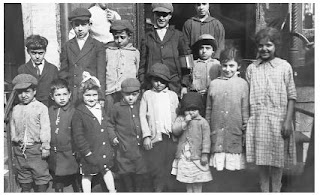First Wave Arab Immigrants
 Arabs have been immigrating to the United States since the late 19th century. These Arabs immigrated for economic reasons, hoping to strike it rich and then go back to their native homelands. Very few of the first Arab immigrants expected to lay down roots in America and establish communities similar to their own in the old country. But they did, like most all other immigrants, and became woven into the fabric of American history.
Arabs have been immigrating to the United States since the late 19th century. These Arabs immigrated for economic reasons, hoping to strike it rich and then go back to their native homelands. Very few of the first Arab immigrants expected to lay down roots in America and establish communities similar to their own in the old country. But they did, like most all other immigrants, and became woven into the fabric of American history.The first Arabs to set foot on American soil came primarily from Syria and Lebanon. They were majority Christian, Assyrian Orthodox, Maronite, or Melkite. When they entered Ellis Island for the first time, they were asked, "Where are you from?" Even further, they were asked to categorize themselves according to race and color, something immigrants knew little to nothing about. Ellis Island officials handled these cases by mislabeling these early immigrants. Historical census sources dated back to the late 19th century and early 20th century had mislabeled many immigrants primarily from Eastern Europe and Asia. They categorized them as 'Turks from Asia', or from the 'Greater Syria'.  "The U.S. census of 1910 listed 497 individuals under the category "Turkey in Asia" (Asian subjects of the Ottoman Empire, most of whom were Arab); in 1920, the number was 1,320. " [http://ech.cwru.edu/ech-cgi/article.pl?id=AA2] However, in the case of Arabs particularly, this group was extremely misunderstood by Americans, and their categorization as 'Turks' made them foreigners in the eyes of Europeans and American nativists alike.
"The U.S. census of 1910 listed 497 individuals under the category "Turkey in Asia" (Asian subjects of the Ottoman Empire, most of whom were Arab); in 1920, the number was 1,320. " [http://ech.cwru.edu/ech-cgi/article.pl?id=AA2] However, in the case of Arabs particularly, this group was extremely misunderstood by Americans, and their categorization as 'Turks' made them foreigners in the eyes of Europeans and American nativists alike.
 "The U.S. census of 1910 listed 497 individuals under the category "Turkey in Asia" (Asian subjects of the Ottoman Empire, most of whom were Arab); in 1920, the number was 1,320. " [http://ech.cwru.edu/ech-cgi/article.pl?id=AA2] However, in the case of Arabs particularly, this group was extremely misunderstood by Americans, and their categorization as 'Turks' made them foreigners in the eyes of Europeans and American nativists alike.
"The U.S. census of 1910 listed 497 individuals under the category "Turkey in Asia" (Asian subjects of the Ottoman Empire, most of whom were Arab); in 1920, the number was 1,320. " [http://ech.cwru.edu/ech-cgi/article.pl?id=AA2] However, in the case of Arabs particularly, this group was extremely misunderstood by Americans, and their categorization as 'Turks' made them foreigners in the eyes of Europeans and American nativists alike. Most Arabs would locate close to their Jewish counterparts in neighborhoods like Brooklyn, the Bronx, and Queens. This was common, as most Arabs and Jews started out their business careers as street peddlers. They sold fruits, coffee, coffee kettles, jewelry, and pretty much anything that was in demand. Not too long later, they would open up their own grocery stores, clothing and hardware businesses, laying ground for the growing capitalism of the 20th century.
Towards the mid-20th century, many Arabs migrated to areas around the Great Lakes, particularly Cleveland and Detroit. In fact, today, Dearborn, Michigan boasts the greatest number of Arabs. Most of the Arabs immigrating to Dearborn moved to join family members. This has alot to do with the Ford Rouge plant that employed a large number of Arabs in the 1920s and 1930s. Communities of these early Arab immigrants revolved around the church or mosque. In the case of Cleveland, St. Elias Melkite Church (est. in 1905)and St. George Antiochan Orthodox (est. in 1911) were key social and community posts for Arabs. These gave rise to Beit Haninah club, the Ramallah Club, and the Aitaneet Brotherhood Association. By 1967, the Islamic Center of Greater Cleveland would be established by several Arab families.
The first wave Arab immigrants assimilated quite easily into the American mainstream, much different from later wave immigrants. This has more to do with push and pull factors. Earlier immigrants hoped to grow wealthy and then move back to their native villages. However, most ended up staying in America and growing accustomed to democracy and capitalism. On the other hand, later waves often came to America to flee political realities. The 1948 Nakba and the 1967 war with Israel, spurred growing nationalism among Arabs distancing them from other Americans.
Regardless, many Arabs would enter into political and socially conscious careers including but not limited to teaching, the arts, media, law, and medicine. What have been your experiences as an immigrant or product of immigrants? Please share your stories on my blog!
 For more information on Arab immigration see the following websites:
For more information on Arab immigration see the following websites:Syrian American History http://syrianamericanclub.com/index.php?option=com_content&view=article&id=48&Itemid=54
The Encyclopedia of Cleveland History http://ech.cwru.edu/ech-cgi/article.pl?id=AA2
Arab Americans and Their Communities in Cleveland by Mary Haddad Macron http://www.clevelandmemory.org/arabs/
'Arab Americans Making a Difference' by Casey Kasem http://aai.3cdn.net/eb843914472c84a043_efm6ibdbq.pdf


Comments
I like to discuss this matter widely if possible .
Thanks alot
iraqoscar@yahoo.com